May 13, 2024
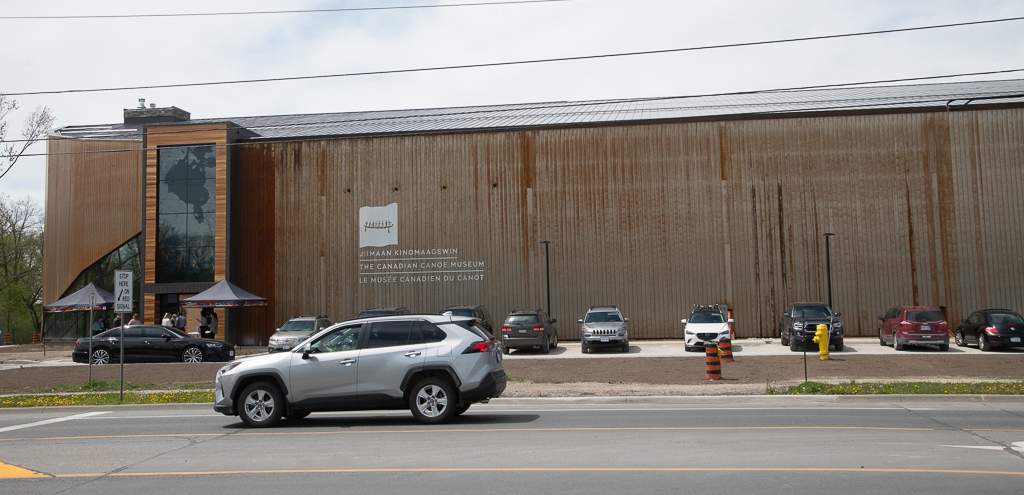
Well it’s finally happening. The Canadian Canoe Museum is opening its new digs to the public on May 13 – and it’s an incredible place, and it’s on the water! So I want to write a blog about where it’s come from and what it will be. I’ve taken some photos as well to give you a sense of it all.
I keep reminding people also of how significant an institution this really is for Canada – and that in 2013, the Senate declared the Canadian Canoe Museum and its collection a cultural asset of national significance. And just recently it was named one of the Best Cultural Spots on National Geographic’s Best of the World 2024 (the brand’s annual guide of the most exciting, meaningful, and one-of-a-kind travel experiences for 2024).
On Saturday, April 20 Penny and I attended sort of a first pass opening for key donors and past board chairs. It was a grand evening. Everyone present could begin to imagine what it would be like when the 100 or so canoes and kayaks (of the over 600 in the collection) would be fully on display in the Exhibition Hall in the six thematic exhibits with all of the appropriate information about the craft. And when we were then placed in front of the 500 or so watercraft in the Collection Hall, stacked from floor to roof, there was an audible intake of breath!

Collection hall
We did learn that the 45 million dollar capital campaign for the museum has been successfully completed. For one who has lived with a lot of fund raising campaigns over the years, these are magical words. (An additional sustainability campaign for 1.5 million is also partially there.) The lead donor has been the Weston Family Foundation; they have led but also have the government partners, and that includes the Government of Canada, through both the Department of Canadian Heritage and the Federal Economic Development Agency for Southern Ontario (FedDev Ontario), the City of Peterborough, Peterborough County, and the Province of Ontario. In addition donors from coast to coast to coast have been generous.
What is it – inside?
The building is architecturally quite wonderful – designed by Lett Architects – a local architect. (They have recently rebranded as Unity Design Studio.) Massive James Bay spruce beams are prominent; a nice touch is the stairs leading up to the second floor – they are made of the white ash milled from the property on which the museum sits.
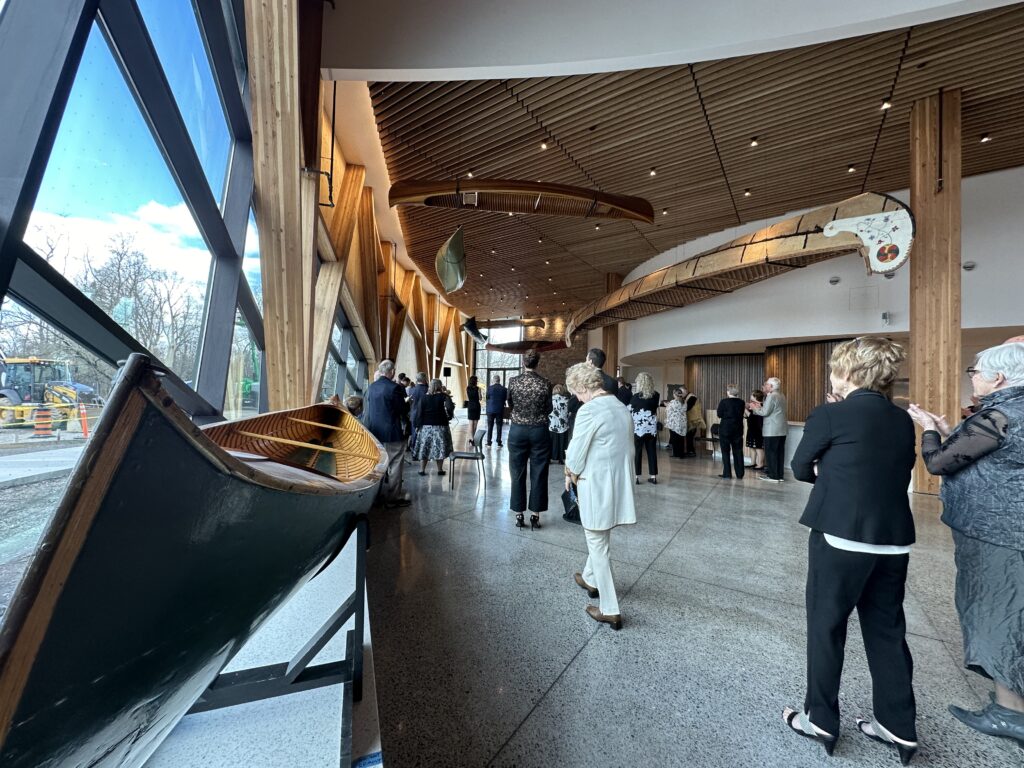
Entrance hall

White ash stairs
Most of the canoes have now been transferred over from the old land-locked buildings on Monaghan Street that was made available from the old bankrupt Outboard Marine operation granted to the museum for a dollar, way back in 1997.
As you enter, above the doors, the windows are etched with a quite striking hydrological map.

Entrance and hydrological map
A spacious atrium rising to the roof of the building serves as a grand entrance hall. The inside provides 65,000 square feet of possibilities on two floors. The architects even figured out an indoor fireplace (to match the one outside the western entrance that’s built into the exterior stonework).

Entrance hall and gift shop
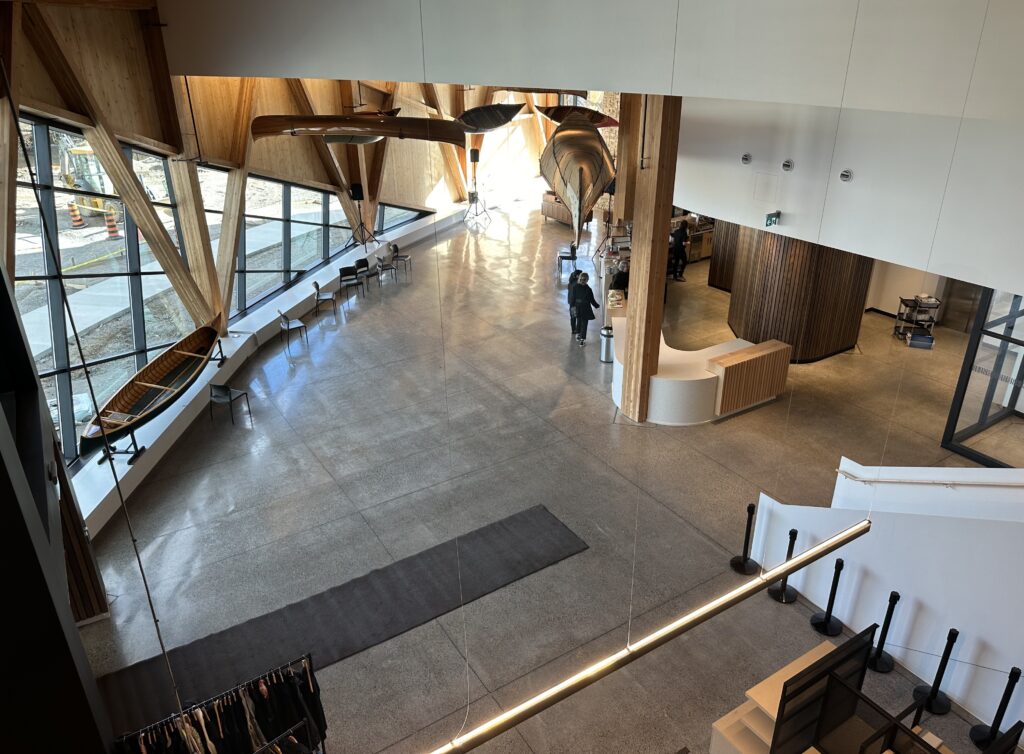
Entrance hall
Of the more than 600 canoes, kayaks and paddled watercraft in the collection, more than 100 will be on display in the Exhibition Hall. One can wander through six thematic exhibits complete with storytelling material (text, audio/visual, etc.)


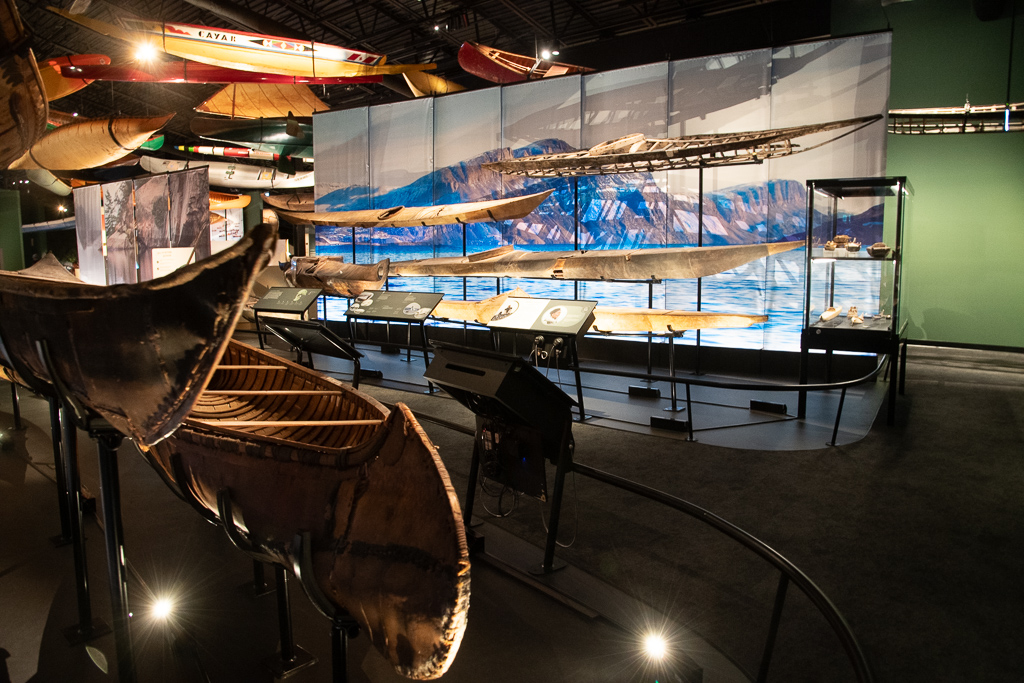
Exhibition hall selection
As you approach it you pass through The Swirl which is a collection of canoes suspended in a circle from the central ceiling – conventional hulls, a dugout, a birchbark canoe, plastic freestyle kayak, carbon fibre sprint racing hull, Grumman aluminum, early 20th-century courting canoe, solo whitewater boat and more.

The Swirl
It will all be presented in three languages, English, French and Anishnaabemowin, the language of the territory, lands and waters on which the Museum is situated. (The Canoe Museum has worked closely with Michi Saagiig Nishnaabeg knowledge holders to translate the Museum’s name into this name.)
A 20,000-square-foot Collection Hall on the first floor of the new museum will house the artifacts that are not on display in the Exhibition Hall. Hanging on hooks and straps or perched on steel racks are over 500 more watercraft. This can be seen from the Atrium and Mezzanine levels through the 23-foot high glass windows. In the many design discussions, this was always a given – that the whole collection should be under one roof; renting off-site space was not desired.
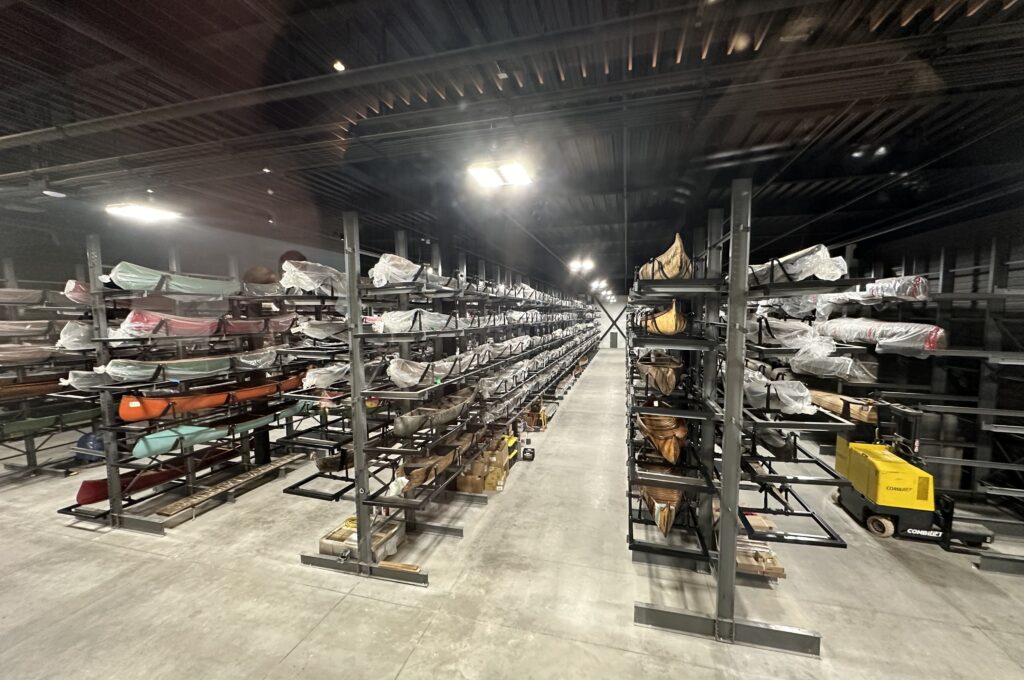
Collection hall
It’s not just a collection of watercraft. The Museum also stewards a collection of paddles and paddling accessories, small artifacts including canoe and kayak models, an archival collection that includes photos, postcards and canoe manufacturing history, and a reference library and a rare books collection on the top floor (over 1,200 books).

Part of library
There of course is more: space (with a great view of the lake) for events which can provide rental income (weddings, conferences, dinners, etc.), a separate workshop for restoration workers, builders-in-residence, etc. and of course administration facilities.

Event space
What about food, drink and gifts?
There is a cafe, the Silver Bean (which also has, since 2003, a spring-to-fall location in Millennium park) serving breakfast and brunch, with a pretty good selection: eggs, yogurt, toast/scones/muffins/bagels, native cereal, paninis, breakfast and regular sandwiches, French toast, smoothies, salads, soups, baked goods, deserts including Kawartha Dairy ice cream. Beer, wine and cider will be available.

Silver Bean Cafe
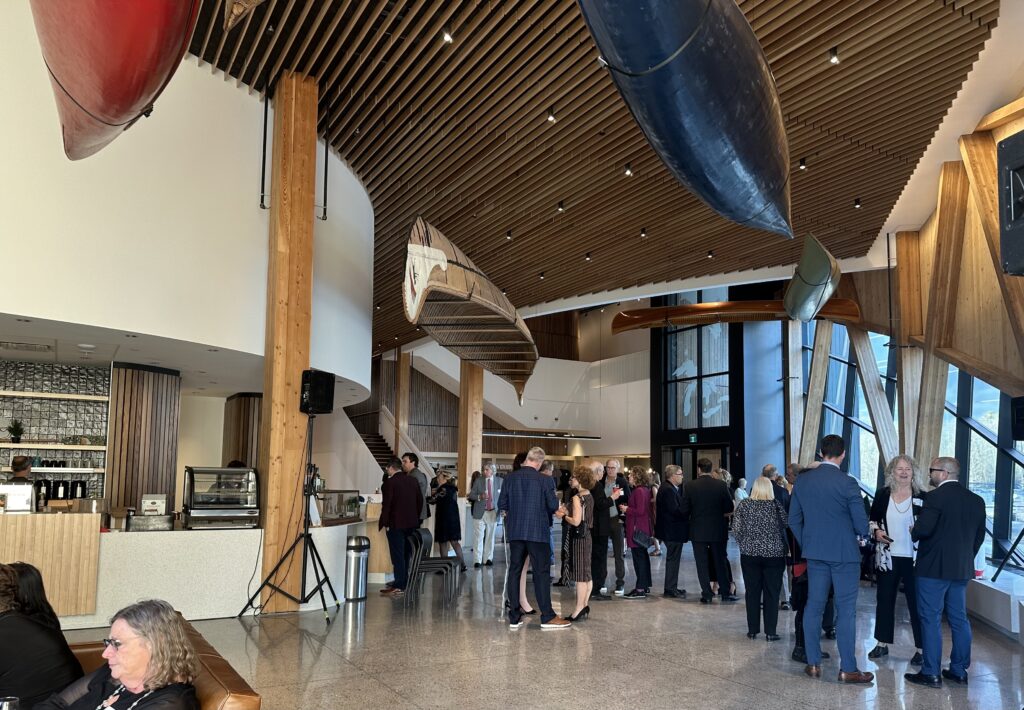
Entrance hall
There will be a gift store featuring clothing, jewelry, books, and one-of-a-kind creations by Canadian artists.
What about the collection?
The collection remains what it is: the largest gathering of canoes, kayaks and paddled watercraft in the world. It has always been quite a selection of craft from around the world – so it’s not limited to just Canada (and most counties have their own canoe history). But it does present a magical vision of how significant a role the canoe has played in the then emerging country we call Canada, and now continues to play.
What is it – outside?
The Museum property features 1,200 feet of shoreline, docks, boardwalks, restored and naturalized spaces, wetlands, and a 2,500 sq. ft. Canoe House. This also serves as a multi-purpose outdoor classroom for learners of all ages. The accessible boardwalk and dock system will enable one to enjoy the water from the shore or by canoe or kayak and are also the home base for paddling lessons. In fact a range of outdoor activities will now be offered, both on land and on the water.

Canoe House
Where is it?
The museum is located on the eastern shores of Little Lake looking across at downtown Peterborough. It sits on a 5.3-acre waterfront property. To the north is the headquarters of Parks Canada; to the south is a city-run park. The campus is also bisected by the Trans-Canada Trail.

Looking west out to Little Lake
The lake is part of the Trent-Severn Waterway, less than a kilometre down the canal from the famous Peterborough Lift Locks, where the new museum almost ended up (a long story that I’ll briefly touch on, that is a fascinating byplay of the whole complicated Canoe Museum story).
The Lift Locks will still figure in the calculus; it is part of the attraction of the city, of the area. This 120-year-old National Historic Site features the tallest hydraulic lift locks in the world, essentially big swimming pools raised or lowered 20 meters to let boats bypass part of the Otonabee River. They’re a big tourist attraction, with 25,000 tourists visiting a year, so a natural synergy with the Canoe Museum will exist.
The front entrance of the museum is located on the east side of the property, on Ashburnham Drive, a major north/south thoroughfare that links straight down to Highway #7 to Ottawa and #115 down to Toronto. On the east side of the street is a huge free parking lot at Eastgate Memorial Park or one can walk through the Beavermead Campground, following the Trans Canada Trail and cross over the pedestrian bridge.
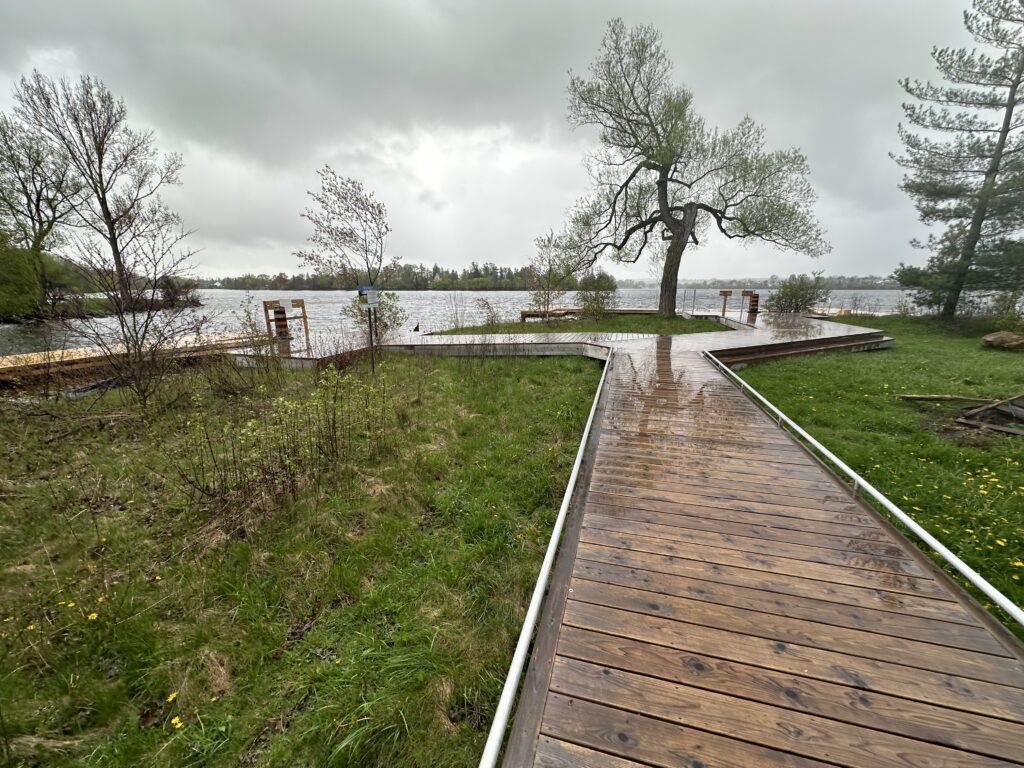
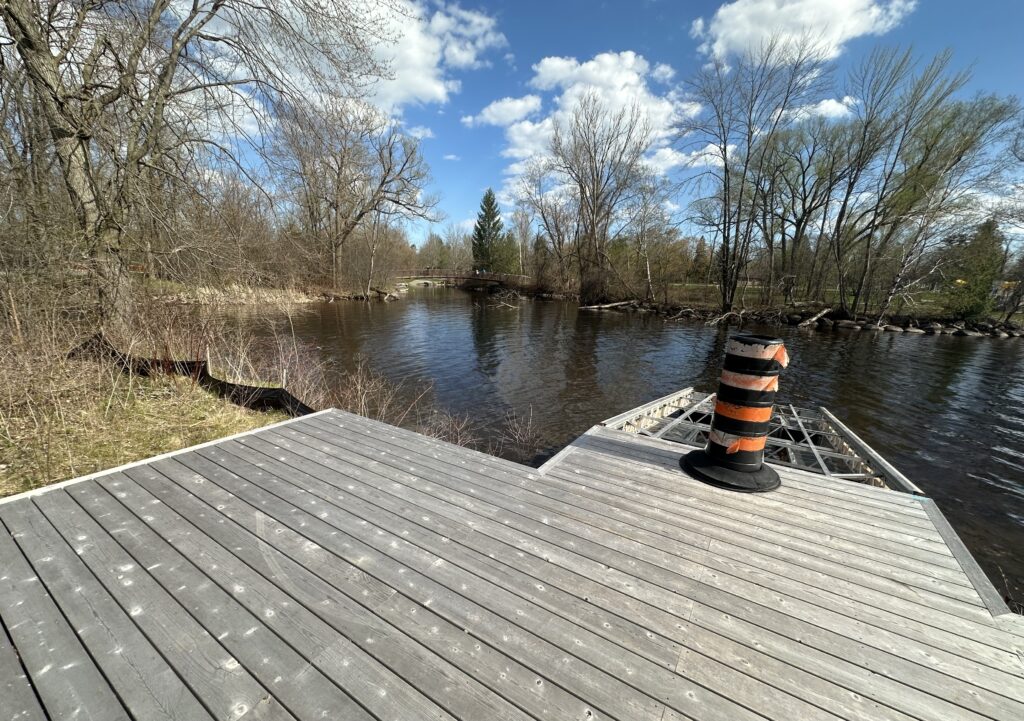
Part of Little Lake docking system
It can also be reached by, appropriately enough, canoe. Paddling up to the docks or the nearby natural canoe launch ramp will do it. Canoes and kayaks will be available for rent or a guided group tour of Little Lake and surrounding waterways in one of the 36’ or 25’ Voyageur Canoes.
Why a new museum?
This new museum was necessary. The priceless collection had to be preserved in a museum quality environment of temperature, humidity, etc. Class “A” Museum Environmental Control standards will now be followed. If not the collection would have continued to deteriorate, as it was gradually doing in the old Outboard Marine facility in the downtown core of the city.
Also if the artifacts were to mean anything to the world, they had to be identified, classified and stories told about them – and in a professional, polished fashion. That’s what museums do. And that’s what was determined we needed to do way back in 2010 with the museum’s “On the National Stage” strategic plan. A pretty good job was done in this regard at the old facility; a more complete and professional remake will be amazing.
Stewardship extends far beyond artifact preservation. The Museum has made a pledge as they say in their website “to foster meaningful connections and inspire new generations of stewards. There is a unique opportunity, with the canoe as the lens, to share Canadians’ stories, aspiring to include and welcome diverse voices and perspectives from across the country.” It’s also a chance to be hands-on for a wide range of users.
Its history
This museum really started back in the late 1950s. Those who have lived with it can recite the key stages, and I won’t go into them; they become part of the lore, the mystery of how the damn thing ever formed and stayed alive.
I will however mention the obvious, that it goes back to an oversized personality by the name of Kirk Wipper who had a private collection of canoes and kayaks. He ran a camp called Kandalore and the canoes that he was passionately collecting started to pile up. Along the way, there have been so many people who have had an influence, that the real story should be written for those who care, and there are and have been many that really do care.
My connection
As this is my blog and while I’m not trying to write the definitive history, I’ll just give some personal snippets of my own journey. I’ll start with one story told to me by my brother-in-law, Claude Cousineau (he’s married to my younger sister Susan). As a professor of leisure studies at the University of Ottawa (and co-founder of the National Canoe Schools and Canadian Recreational Canoeing Association), he was a close friend of Kirk Wipper.
Back in the 1960s Kirk asked Claude to help him bring back a very large Haida canoe from Haida Gwaii (then called the Queen Charlotte Islands.) Kirk had been dealing with the local Haida chief regarding obtaining a large sea-worthy canoe, which he was eventually given. In typical fashion, Kirk decided that he and Claude would (could?) paddle it across the Hecate Strait separating the islands from the BC mainland, which at the point where they were departing from was over 40 miles. Well it’s not a gentle crossing, and it proved not to be that day.
After a few hours of paddling following a map and compass bearing, luckily Kirk and Claude flagged down a local fishing boat who told them they were not heading for the Straight but rather were further out to open sea. Apparently the tide had veered them off course. The fishermen advised them to turn around and head straight back to the islands as the looming weather and rough waters were becoming too treacherous. Safe, but a bit humbled (if you could ever humble Kirk), the two made it back to Masset, the small town from which they left. The post-story follow-up was that Kirk eventually got his canoe after arranging for it to be shipped back to Peterborough. That’s one of many very colourful “Kirk” stories.
Like many in the Peterborough community, my wife Penny Rush, and I have been living with the canoe museum saga for many years. Penny has been involved way before I even came to Peterborough, as a volunteer. I was asked in the late 1990s if I would provide photos for the large main floor dioramas of canoe and paddling scenes. Some 15 of my photos have graced these huge displays for over 20 years.
Then the museum “vacuum” took over and it has a very strong inhale system! Before I knew it I was on the board of directors, and subsequently chair from 2013 to 2015. I followed Jon Grant, Verne McKay, Don Curtis, Barry Diceman, Jim Stewart and Jim Matthews. And was followed in turn by Bill Morris, John Ronson, Vickie Grant and the current chair Kevin Malone.
I was part of the Liftlock site phase and actually signed a Letter of Intent between CCM and Parks Canada to a 42 year lease with Parks Canada on April 2013. An award-winning uniquely designed building was then designed with sweeping, curved glass walls and a 1.5-acre green roof, complete with a pollinator garden. However as construction approached in 2020 new groundwater sampling uncovered an industrial degreasing solvent from the former clock factory uphill. Fortunately private and public donors hung in and a major recalibration took place and we are now where we are today.
Dogged, enthusiastic people have kept this alive.
Most recently the weight of the project has been shouldered by both the executive director, Carolyn Hyslop (who has been at the Museum for over 20 years in various levels of increasing responsibility) and the museum’s curator, Jeremy Ward, who has also been around for more than two decades. They, their staff and the current board, led by the chair Kevin Malone, have successfully stewarded the museum forward.
While there are so many people who have gently prodded or violently goosed the museum forward, some names come to the surface. When I started to write this I realized that if I mention one, then I would be in danger of leaving another out. So I have taken the cautious route and will just leave it with the fact that many, many have contributed, lobbied and sung the museum’s praises to a wide range of influencers all these years.
The fact that the museum has been built in Peterborough reflects the reality that most of the early prime movers were local. The energy year after year to keep this museum alive has been very much local energy. The obvious fact that the early Canadian canoe building companies resided in the city helps.
Part of the energy is reflected in the very loyal and active volunteer cadre; they take on so many activities that both help control costs but do it with a genuine love of the task – and that’s reflected in the visitor experience (reception and store tasks, canoe and facility repairs, committee or board work of a wide variety, etc.)
The list of major donors is also quite extraordinary. The Museum is an icon that is truly a cross-Canada one, so as a result money has come supporting the museum from all over Canada.
The contributions of Indigenous Peoples including First Nations, Inuit and Métis, in shaping this country are reflected in so many ways and that means in an institution such as the Museum. Not the least of the fact that over one-third of the collection is of native origin. Indigenous Peoples around the world designed, built, and used the first canoes and kayaks.
The Museum has a National Council – a group of over 70 distinguished individuals who are passionate about the work of the organization and believe in the importance of the canoe to Canada, and have lent their support and enthusiasm to the building of this new museum. Their names can be found on the Museum’s website.

Lake (back) side of new museum
Wrap up
So now to show it off. I’m going to book a tour for a group of my old Camp Ahmek buddies. They’ve decided to make an excursion of it and take a limo up from Toronto. I’ll suggest that we take the hour long group tour with a docent. Then we’d probably go into the Collections Hall to hear the stories of the artifacts currently not on display in the Exhibition Hall, use the onsite café for an artisanal lunch, and head back.
My men’s book club will do likewise, as well the “tennis” group and other such groups that Penny and I are part of, and then family and friends will all be encouraged to absorb its magic. In 2007 the canoe was declared by a CBC panel to be first among the Seven Wonders of Canada. It’s going to be fun to show off the place celebrating this wonder.
Thank you so much Ken for telling and sharing this story.So Canadian!
Will be sure to come to the opening and to send your blog to all three sons.
Thanks Ken. I do get the Museum’s notices etc, but this is just great.
Very informative, and great pics as always!
Next time I get to Ontario, it is a place I have to go to!!.
I did work at Camp Kandalore with Kirk. ( a very long time ago)
First canoe tripping at Wapameo, then Kandalore….
and wide variety of canoe expeditions since.
Thanks for this info.
Ken,
Nice commentary and easy to follow. I think that all past donors should be given a heads up that the museum is opening.
Doug
It has been a long paddle. In the 1970s Ted and I displayed some of the Candelore canoes in our display at the Toronto Boat Shows helping Kirk promote the collection. The years in Peterborough while we helped to relocate the collection are a distant memory.
We will not attend the special opening events but rather make a quiet family visit at a later time.
We are happy that the huge project has been completed and hope the plan for the future is sustainable.
Hi Ken
You have made a big effort to support the museum along with your wife Penny. Your photo skills will be appreciated in documenting progress & life at the museum.
Good work. Seeing Kurk Wipper & his background of Camp Kandalore bring many memoties as well.
Well done
Ralph Grose
a very long time friend from Blythwood days.
Congratulations Ken (Penny) and to all your many colleagues on this amazing accomplishment . Judy and I look forward to our first visit to the new Canadian Canoe Museum!
Ken..here’s a canoe related fact you may not know…in 1689, Iroquois attacked and basically wiped out Lachine.
They were able to effect their silent stealthy and subsequent deadly attack without raising any onshore alert because they used elm bark canoes. Elm was the canoe bark of choice in upstate New York.
Dark in colour so not light reflective like birch and heavier, their canoes rode lower and quieter in the water.
They beached undetected..1500 est warriors…killed most of the men and captured the women and walking children for slaves, trading and/or the soup pot.
Don’t know if any elm bark canoes survived but certainly have a place in Canadian history…..Cheers and good work.
Really great write-up and preview of the new museum Ken. Thanks for sharing your in depth experience!
Nicely done Ken. Wendy and I are looking forward to visiting the museum with our family and friends. Many thanks for your contributions to bringing this dream to reality. Special thanks to Penny for keeping you on track.
All the Stoney Lake cottagers send out a big thanks to you Penny and all your team
Awesome !!!
Fascinating journey Ken I live in Port Hope these days so a visit will be on my calendar.
Congrats Ken. Must be so great to have this beautiful building and legacy in place. Can’t wait to visit
A constructive narrative, Ken. There is so much history in this magnificent journey. We will absorb it all at the grand opening!
Great blog Ken.
The Halliwell family of Crowe Lake and Sterling, donated a Rice Lake canoe to Keith 30 to 40 years ago. I had not seen it in the old museum and maybe it will be shown in the new. Regardless, a great accomplishment. How! How! Kilcoo days.
Ken, we all are (or should!) be grateful to the many people whose work, dedication, persistence and vision that has brought this wonderful facility to life. It’s a treasure, and I can’t wait to visit. Also, a lovely draw for visitors to our lovely city.
Well done Ken .I look forward to the long portage and celebrating with you. The AHMEK SPIRIT lives on ! Tom Sanderson
Ken, I appreciate your comments, but I think you should have named at least some of the wonderful volunteers who have made this all happen.
I think that All of the wonderful volunteers should be especially thanked, because without them this move of the Canoe Museum would not have happened.
I agree, and I wrote a few paragraphs on about 8 people.Then as I said, it was obvious that I would miss someone, and that perhaps would be worse. Maybe as a supplement!
Ken
A truly amazing journey for an amazing person! I sadly had no camp experience in Ontario as a boy but have enjoyed local paddling on and off ever since Ann and I moved to Peterborough, and we have consistently been drawn back to the canoe museum time and again. this is a national treasure and you and your team should be proud. we will continue to support this new Canadian icon.
What an incredible job, Ken! It brings back wonderful memories of many summers at Ahmek, particularly one spring when I “assisted” that master canoe-builder from Peterborough, Stan Murdock.
Ken, thank you for this wonderfully detailed blog. I knew some of the story, but so much I did not know. It’s history the City of Peterborough along with those who had the foresight to persevere to make this happen should take pride in seeing it come to fruition.. It’s a wonderful legacy for future generations to enjoy! You, Penny and so many others need to be congratulated! I look forward to visiting at some point in the near future.
Ken
Fascinating blog! Well done.
As you know, I grew up in the Bahamas, where we had different water craft, but no canoes. I would be interested in a visit when you have a group of friends scheduled. Perhaps sometime this summer
Lionel Colman
O can sense you burning the
Midnight oil on this well written blog👍😃✅
Good’eh Ken,
Interesting article. Glad you mentioned the Cousineau connection. It completes part of my puzzle. If you read my articles you will see what I mean.
If you goto:www.thetimetraveller.ca and search for “Kanawa on the Move” and “The Canadian Canoe Museum” it should be self-explanatory.
You may find “Frank Falls” of interest as well.
Barney Moorhouse